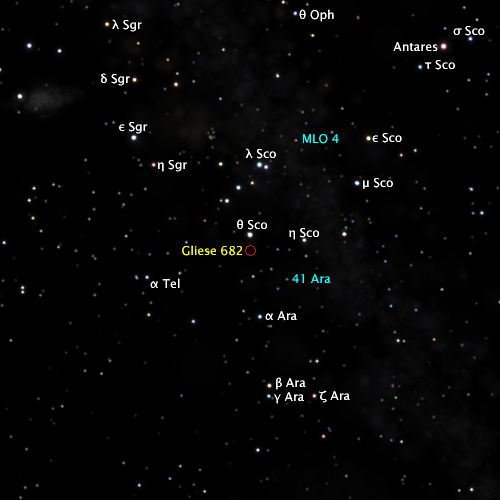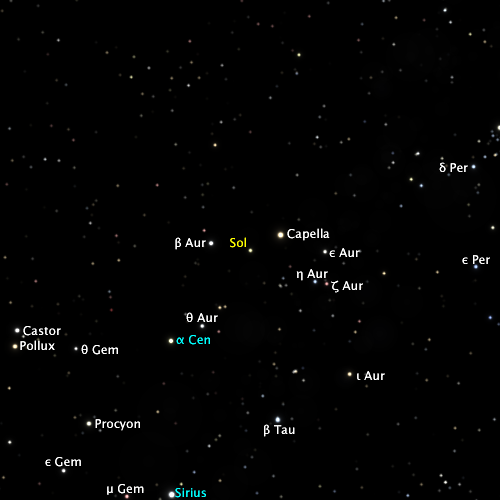as seen from Sol.
Gliese 682.


| Right Ascension | 17h 37m |
|---|---|
| Declination | −44° 19' |
| Distance | 16.34 ± 0.19 ly |
| Spectral Class | M3.5V |
| Estimated Mass | 0.21 × Sol |
| Luminosity | 0.00660 × Sol |
| Gliese 682 as seen from Sol. |
Sol as seen from Gliese 682. |
|---|---|
 |
 |
| Star | Magnitude | Distance |
|---|---|---|
| Canopus | −0.63 | 307.4 |
| Arcturus | −0.03 | 37.1 |
| Rigel | 0.21 | 872.9 |
| Vega | 0.31 | 28.5 |
| Achernar | 0.36 | 133.9 |
| Betelgeuse | 0.51 | 511.1 |
| Beta Centauri (Hadar) | 0.54 | 378.8 |
| Sirius | 0.58 | 21.6 |
| Alpha Crucis (Acrux) | 0.70 | 310.9 |
| Alpha Aurigae (Capella) | 0.78 | 59.1 |
| Altair | 0.78 | 16.8 |
| Spica | 0.92 | 242.8 |
| Fomalhaut | 0.97 | 23.0 |
| Antares | 1.00 | 538.7 |
Gliese 682 is a red dwarf star located about 16.3 light years from Sol. It is a dim star with a luminosity of about 0.0066 Sols.
| Destination | Distance |
|---|---|
| Alpha Centauri A | 12.8 |
| Epsilon Indi | 11.0 |
| Gliese 432 | 29.3 |
| Gliese 832 | 11.0 |
| Gliese 667 A | 6.8 |
Gliese 682 has a system of five planets, which are all named after fire gods.
The sky map showing Sol as seen from GJ 682 is a representative view only. It is not possible to view the night sky from the inhabited regions of Prometheus because that world is tidally locked to its sun and the inhabited regions do not experience night. However, the view can be seen from spaceships in orbit above Prometheus or by visitors to the night side.
| Planet | SMA (AU) |
Orbital Period |
e | Equatorial Diameter (km) |
Mass (Earths) |
Density (g/cm3) |
Gravity (Earth g) |
Atmospheric Pressure (Earth=1) |
Sidereal Day |
Mean Solar Day |
Axial Tilt |
Known Moons |
|---|---|---|---|---|---|---|---|---|---|---|---|---|
| Prometheus | 0.08445 | 19.561 d | 0.0010 | 14360 | 1.473 | 5.67 | 1.161 | 1.63 | 19d 13h 27.7m | Synchronous | 00° 04.1' | 0 |
| Belenus | 0.1453 | 44.129 d | 0.0235 | 9451 | 0.2969 | 4.01 | 0.5406 | 0.204 | 44d 03h 06.0m | Synchronous | 00° 23.7' | 0 |
| Adranus | 0.2569 | 103.78 d | 0.0446 | 13450 | 0.4780 | 2.24 | 0.4294 | 1.34 | 103d 18h 38.8m | Synchronous | 01° 37.0' | 0 |
| Perun | 0.8717 | 1.7759 y | 0.0570 | 62720 | 26.17 | 1.29 | 1.082 | &mdash | 11h 49.3m | 11h 49.8m | 13° 44.8' | 10 |
| Feronia | 1.608 | 4.4508 y | 0.0348 | 43270 | 9.660 | 1.44 | 0.8391 | &mdash | 13h 15.3m | 13h 15.5m | 28° 14.6' | 11 |
| Name | Diameter (km) |
Period (days) |
Semimajor Axis (km) |
Ecc | Inc |
|---|---|---|---|---|---|
| Natural Satellites of Perun | |||||
| Perun VI | 83 | 1.017 | 126800 | 0.0462 | 0.05 |
| Perun I | 1768 | 1.524 | 166100 | 0.0022 | 0.32 |
| Perun II | 1385 | 3.056 | 264100 | 0.0061 | 0.23 |
| Perun III | 1951 | 6.111 | 419200 | 0.0109 | 0.48 |
| Perun V | 431 | 9.163 | 549200 | 0.0171 | 1.30 |
| Perun IV | 788 | 15.24 | 771000 | 0.0334 | 0.25 |
| Perun VII | 61 | 15.24 | 771000 | 0.0572 | 0.35 |
| Perun VIII | 177 | 60.97 | 1943000 | 0.0173 | 1.56 |
| Perun IX | 54 | 79.54 | 2320000 | 0.0610 | 0.80 |
| Perun X | 61 | 185.6 | 4081000 | 0.0938 | 4.51 |
| Natural Satellites of Feronia | |||||
| Feronia VI | 44 | 0.6821 | 37200 | 0.0006 | 0.22 |
| Feronia VII | 72 | 1.015 | 48480 | 0.0116 | 0.17 |
| Feronia IV | 455 | 1.401 | 60110 | 0.0141 | 0.35 |
| Feronia III | 939 | 2.521 | 88920 | 0.0031 | 0.78 |
| Feronia I | 1262 | 4.327 | 127500 | 0.0213 | 0.45 |
| Feronia II | 1640 | 9.564 | 216300 | 0.0023 | 0.17 |
| Feronia V | 477 | 12.84 | 263200 | 0.0021 | 1.41 |
| Feronia VIII | 25 | 24.07 | 400300 | 0.0453 | 9.49 |
| Feronia IX | 87 | 30.50 | 468700 | 0.0589 | 16.46 |
| Feronia X | 57 | 155.3 | 1387000 | 0.3195 | 177.61 |
| Feronia XI | 34 | 331.4 | 2299000 | 0.5545 | 69.46 |